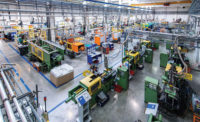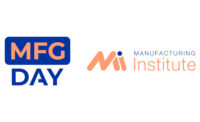Optimism regarding the prospects of the U.S. economy over the next 12 months rose to 30% in the fourth quarter of 2011-up from only 5% in the third quarter of 2011-and 28% of respondents believe that the U.S. economy grew in 4Q 2011, up 21 points from the prior quarter. However, the majority of respondents, 57%, remain uncertain, rather than outright pessimistic. Among U.S. industrial companies operating abroad, uncertainty also remains high at 64%, with 36% believing that the world economy is declining and 48% reporting that they saw no change. However, 16% of respondents marketing abroad view the world economy as growing in the fourth quarter of 2011, up 9 points from the prior quarter.
“While forecasts remain guarded with growth rates trailing prior year actual performance, optimism about the worldwide economy increased among U.S. industrial manufacturers in the fourth quarter of 2011," says Barry Misthal, global industrial manufacturing leader for PwC. “Despite the improved sentiment, however, the majority of U.S. industrial manufacturers remain cautious regarding the outlook ahead. Expectations for moderate growth in 2012 appear to be balanced by healthy cash levels, improving gross margins and continued strategic investment spending among the major industrial manufacturers. Management teams continue to seek avenues to expand globally and gain market share, while carefully managing their risk exposure.”
Growth
Although the projected average growth rate for own-company revenue for 2012 was lowered from 5% in the prior quarter to 4.4% in the fourth quarter of 2011, 83% of respondents expect positive revenue growth for their own companies in the year ahead, while 7% expect growth to be negative and 10 percent expect no growth. With regard to the international contribution, industrial manufacturers continue to expect international sales to deliver 38% of total company revenue in 2012, the same as the prior quarter and one year ago.“While optimism about the international economy remains well below sentiment recorded in last year’s fourth quarter, expected sales contributions from overseas operations remain identical with prior year levels,” added Misthal. “At the same time, plans for spending and M&A activity continue to be a major international focus over the next 12 months. Given ongoing issues facing Asia and Europe, these findings may point to a stabilization of sentiment regarding the global outlook.”
Looking back at full year 2011, the composite average growth estimate for own-company calendar year revenue growth was 5.3%, down slightly from 5.6% projected in the third quarter survey. Eighty-seven percent of respondents said they had positive own-company growth in 2011, with 19% forecasting double digit gains and 68% projecting single digit gains. Eight percent were negative, while only 5% had zero growth.
Spending
Throughout the next 12 months, 67% of industrial manufacturing panelists plan major new capital investments, up 12 points from the third quarter of 2011. The level represents the highest in the past five quarters, with two-out-of-three U.S. industrial manufacturers planning spending. However, the average level of new investment spending is expected to be lower at 4.2% of sales, in comparison to 5.9% in the third quarter of 2011. Ninety percent of respondents plan to increase operational spending, an increase of 5 points from the previous quarter. Increased operational spending is cited for new product or service introductions (57%), information technology (50%) and business acquisitions (40%). Forecasts for research and development spending declined 8 points to 40% from 48% in the third quarter of 2011, while spending forecasts pertaining to marketing, sales promotion and advertising remained low.M&A
On the M&A front, 38% of industrial manufacturers say they planned activity, with virtually all of them seeking to pursue acquisitions. Forty percent plan for expansion into new markets abroad, and 40% plan new joint ventures. The number planning strategic alliances rose to 35%, and new facilities abroad increased to 32%.“The increase in planned operational spending, as well as M&A activities reflects an ongoing focus among U.S. industrial manufacturers in investing for growth in the face of an uncertain global outlook,” added Misthal. “In addition, industrial manufacturing companies have continued to build liquidity, while taking steps to improve margins and provide ample support for investment in growth initiatives with a global focus.”
During the fourth quarter of 2011, 38% of respondents reported higher gross margins, while only 15% said they were lower, for a net gain of 23%. These results are up 15 points from the third quarter of 2011, despite a continued high level of costs. In fact, 32% of U.S.-based industrial manufacturers reported higher costs, while 15% reported cost reductions, for a net plus of 17%, 11 points below the third quarter. In addition, 30% raised prices, but 8% lowered them, for a net plus 22% reporting higher prices, up 12 points from the third quarter.
Employment
Looking at the employment picture, 37% of respondents plan to add employees to their workforces over the next 12 months, off 1 point from the third quarter of 2011. However, the net workforce composite projection rose from a minus 0.2% in the prior quarter to a plus 0.7%, representing modest gains and a break from what had been a declining hiring pattern in past surveys. Among those respondents planning to hire, the most sought after employees will be professionals and technicians (28%) and skilled workers (23%). Interest in production workers declined to 13%, off 14 points from the third quarter of 2011.Regarding expected barriers to business growth, legislative and regulatory pressures were cited most by respondents at 50%. Lack of demand and oil/energy prices were next at 47%, with both being down from the previous quarter. Taxation concerns dropped 7 points to 33%, while concerns about decreasing profitability fell sharply to 18%.
“The success of U.S. industrial manufacturers in increasing operating profitability remains a major bright spot in the prolonged challenging global marketplace,” added Misthal. “In the fourth quarter PwC Manufacturing Barometer, concerns about profitability holding back growth were the lowest in over 12 months, highlighting the fundamental strength of U.S. manufacturers in spite of ongoing sales pressures and intense global competition.”
Special Topic: Supply Chain and Global Operations
U.S. industrial manufacturers continue to focus on improving company supply chains globally. According to the fourth quarter PwC Manufacturing Barometer, three quarters (77%) of industrial manufacturers surveyed believe it is very or extremely important to the growth of their global businesses to improve their companies’ supply chain over the next two to three years.Forty three percent of respondents confirmed it is very/extremely important to improve their companies’ globalized product development operations, while 40% sited their supply base and 39% cited their manufacturing footprint as major priorities. In addition, 75% of respondents confirmed definite plans for major/minor improvement of their globalized distribution systems over the next 12 to 18 months.
Moreover, 78% of industrial manufacturers surveyed believe their current business is scalable to meet global requirements at target performance levels over the next two to three years-50% definitely and 28% probably. The majority (52%) of respondents envision the need to rethink and/or reprioritize their companies’ manufacturing core competences to grow and optimize their business during the next two to three years. Overall, 57% of industrial manufacturers see a need to partner in new ways with their strategic suppliers to grow and optimize their business over the next two to three years.


